“They just aren’t going very deep,” she said. “I know they can do more.”
I asked whether they had been using the Generative Questions during previewing, and she said that they probably hadn’t done as much with this as they should. I figured she was probably right, and asked for permission to play.
And so begins our story.
Previewing a Text
On this day, the class was exploring an interesting article from biography.com entitled, Christopher Columbus: Hero or Villain? (Note this article is also available in TextDepot as a PDF ready to download and print.)
Misty read them the title, then asked them to take 2-3 minutes to preview all six pages while we stepped back to observe. Because they had been working on previewing since the beginning of the year, and because they knew how to use the class anchor chart if they needed it, we expected them to know what to do and to do it without instruction or reminders.
As they previewed, Misty and I observed. We looked for students to take these specific actions, or what we call “look-fors” in HPL:
- Looking through the whole text quickly, turning the pages, and putting eyes on each page (to see what was there and how it was organized—this is Preview 1),
- Going back for a second, slower look, reading the headings and looking closely at the map; a number of them were observed reading the first sentence of each paragraph, as well. (All of this is Preview 2.)
Almost all of them were, indeed doing these things. Yay!
As we observed each reader, we also looked for the absence of the following behaviors, which indicate that students are not previewing:
- Staying on one page for too long; not turning the pages to look through the whole text, and
- Reading the whole text (reading paragraph by paragraph rather than sampling the whole thing; evidenced by underlining and highlighting within paragraphs and not turning pages).
Of course, this being real life, we did have two kids who were still determined to plow through the article from the first word to the last. When we observed this, we intervened by referring them to the Previewing anchor chart and asking them to use it to guide their actions. Then we stood back to make sure they did. [Note]
Reflecting on what we learned from our students: What do they understand about this?
When we asked the group to share what they had learned from their preview, I immediately understood Misty’s concern that they weren’t getting as much out of previewing as they should be. Because when we asked the first Generative Question, “What do we know so far?” most of them focused on talking about the text features the author used to organize the text—not on what they learned about Columbus by reading those headings, illustrations, and first sentences.
Uh oh.
Because when we teach them how to preview, we do—and we did–teach them to notice text features and the organization of the text. But this is a means to an end—not the purpose of previewing!
Reflecting on what we know about Previewing
The purpose of previewing is to build background about a topic.
Preview 1 for a six-page article should take about 10-15 seconds. Preview 2 should take no more than 2-3 minutes. (Yikes! Really? Yes, really! It’s that fast.)
When we make ourselves preview before reading (and most of us do have to consciously force ourselves to preview because it is not a habit) we will be surprised by how much we are able to pick up in an extremely short period of time. But until you experience that surprise, you are unlikely to make yourself do it.
Why are we able to pick up so much so fast by previewing?
As teachers, we have to be really clear about exactly what it is that we want kids to experience. Only then can we backward plan to make it happen.
It appeared that Misty’s kids were going through the motions of previewing, without actually experiencing previewing as a powerful tool to build understandings. We had to change that.
We need them to be able to say, “Man! I can’t believe what I just learned in 2 minutes! Wow! That was pretty cool. I think I’ll do this the next time I pick up something else like this!” We need them to feel the power of previewing–as something they can do to propel their own learning; something that makes learning easier.
The Generative Questions, combined with specific feedback, help us to do just that.
Becoming Strategic (vs learning a strategy)
We have to realize that when we are trying to teach kids how to do something new (like previewing) using a whole-part-whole approach, we as teachers, are prone to get stuck in the parts—the how to—and forget to keep our eye on the why, on the reason why we’re doing whatever it is in the first place! (Forgive yourselves, teachers. The struggle is real!)
In whole-part-whole teaching, it is really important to not overdo the part part. We could use a swimming metaphor here. Think about diving below the surface. You can only hold your breath so long. You have to come up for air. When teaching kids the nuts and bolts of how to preview, we have to keep them focused on the reason we’re doing this in the first place: to make sense.
We use GQs during previewing because they focus the reader’s (and our) attention on what they are learning about the topic, itself, lifting them out of the how to, to focus on meaning making.
Generative Questions
What do you know so far? What else? What else? How do you know?
I explained to them, “When we asked, ‘What do you know so far?’ we wanted to find out what you learned about Columbus when you previewed this article, not what you noticed about how the author organized the text. We talk about that only so we can make a quick plan for how to preview the article to learn what it’s about. If it has headings, you read them. If it paragraphs, you can read the first sentence of each.
“So, what did you learn by reading the headings and first sentences of paragraphs? What did you learn by reading the map? Let’s take a minute to focus our attention on that. Because you did those things. What do you know so far?
“Turn your article over. Now quickly, in one minute, jot down three things you learned about Columbus when you previewed this article.”
We asked them to Think-Pair-Share, with a focus on ensuring that every student articulated something they learned:
Think: We gave them one minute to quickly jot down—in their own words—three things they learned from their 2-minute preview.
Pair: After that, we gave them another minute to talk about what they jotted down with a partner.
Share: Then we asked them to share out with the whole group.
As they shared with one another, Misty and I observed to be sure that every student—especially the ones who prefer to get lost in the woodwork—got a turn to talk, as well as encouragement and help to explain things in their own words if they needed it.
To the left is our list of the information they shared out…(which is pretty cool…):
We want our kids to value previewing because of how much it helps them as learners. To do that, we need them to experience the surprise and pride that comes with figuring out a whole lot quickly by previewing. Then we have to help them to connect previewing with the possibility that they can power up their learning by doing this routinely.
So we stopped to celebrate what they were able to figure out independently. We used process-specific feedback to draw the lines between what they did (preview a long text) and what they learned (our shared list) in a really short time (2 minutes to preview, 1 minute to jot, 1 minute to Pair-Share). We said,
“Wow! You did it! Look at all of the stuff you figured out in just 4 minutes! How did you do that? Yeah! You read the headings and the subheadings. You read the first sentences of paragraphs. You studied the map. And you thought about what you were learning. You talked to a partner …and look what you figured out—all by yourselves! Guys, that’s amazing! You must feel great!”
And they did.
The Next Generative Question
What don’t we know?
After focusing on what we do know, we turn attention to the GQ, “What don’t we know?” This GQ is intended to help students to generate their own questions, and to teach them that it is really, really smart to ask questions about anything you don’t know or aren’t sure about. That’s how we learn. After all, who goes looking for answers to questions they don’t ask?? To grow, we have to figure out what we don’t know.
There are a couple of hard parts about this particular GQ
The hardest thing about this GQ is resisting the temptation to answer kids’ questions. Don’t do it. Write them down.
You’ll also find that some kids are eager to answer other kids’ questions as they ask them. Don’t let them. Write them down. Help them to understand that asking questions is important for our learning…and we don’t all have the same questions. Already knowing something doesn’t make us smarter than someone who doesn’t already know. We make ourselves smarter–we learn–by asking questions and looking for answers. Those questions will be different for different people.
You’ll quickly realize that some kids (especially kids who have a lot of themselves invested in displaying how much they already know) have a hard time when they’re asked to talk about what they don’t know. ‘What? You want me to admit that there’s something I don’t know? Not me, lady. I’m smart!’
Note that a few questions will arise as students talk about what they do know with the first GQ. For example, notice the first question on their list of what we don’t know (at left)—is he dead?—was listed as a question and then answered a few minutes later, as they continued to make their list of what they already knew. When the question came up, we wrote it down. A few minutes later, when another child discovered the date he died, we put a line through the question and answered it.
A list of what they came up with is to the left. As we finished up our list of questions, the kids were excited and proud of themselves. They were eager to read the article to find the answers to their questions.
The Power of Generative Questions during Previewing
All of the New Norms for Learning in HPL are intended to help kids to become constructive, active, strategic readers—readers who are able to build their own understandings by using what they do know to construct understandings about what they don’t know. The Generative Questions provide a framework for that process, focusing attention first on drawing forward and thinking about what we do know so we can start considering all the things we don’t know.
Knowledge construction through this process has to start during previewing so that before readers enter into reading complex informational texts that have:
- A good overview of the big ideas in the text,
- A mental roadmap about where topics and ideas are located and how the text is put together,
- Background knowledge that they have activated themselves by focusing on what they do know (which they do by relating what they picked up during previewing to their own personal stores of knowledge and experience—which are different for everyone), and
- Questions about what they don’t know and wonder about.
Generative Questions across the Disciplines
In our work with K-12 teachers in HPL, we have been exploring how Generative Questions during Previewing help students to ground themselves with whatever they already know about a topic, a problem, or piece of writing before actually diving in to read closely or work the problem.
High school teachers who attended our ACT trainings saw how these questions, used in conjunction with previewing, help us to quickly build a good, basic understanding about the long passages kids have to read for the ACT. (In fact, we found out that unless kids learn how to do this on every one of the subject area tests, they won’t do well on ACT or any other long, grueling, timed test!)
Math teachers have been exploring how GQs and previewing help us to gather together everything we know about a problem, so we can think logically about how to solve it.
Science and social studies teachers are learning that we can gather an incredible amount of information about a long text in just 2-3 minutes, making it easier to determine what needs closer reading and what can be skimmed and scanned.
Math and science teachers are learning how much there is to learn (and teach our kids) about reading the graphical information in charts, graphs, diagrams, maps, and models.
ELA teachers are learning how using GQs, together with turning and talking or talking to oneself at the end of a page or a few paragraphs can help kids to deepen their understandings and to identify their confusions and questions before moving on.
Teachers in early childhood classrooms are learning how powerful previewing is for our youngest readers who learn to independently preview a story or an informational text before reading it.
Generative Questions focus attention on meaning-making before reading, making it easier to read with understanding. They are a powerful tool for generating thinking when they are used and appropriated by readers. Truly, if we teach ourselves and our kids to use even the first four of the GQs, we can significantly boost both engagement and understanding.




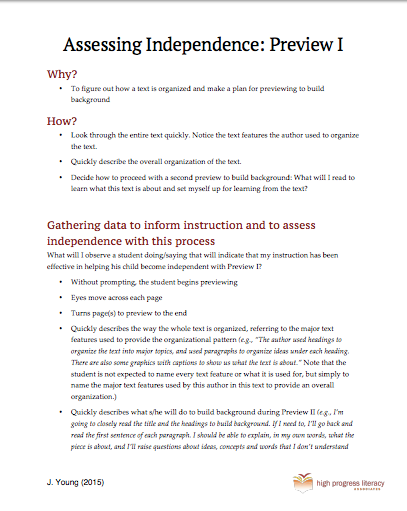

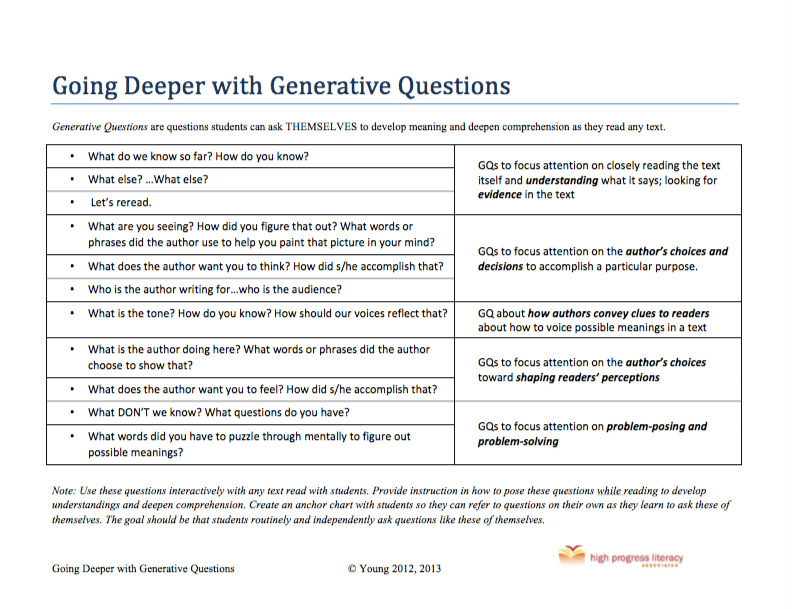
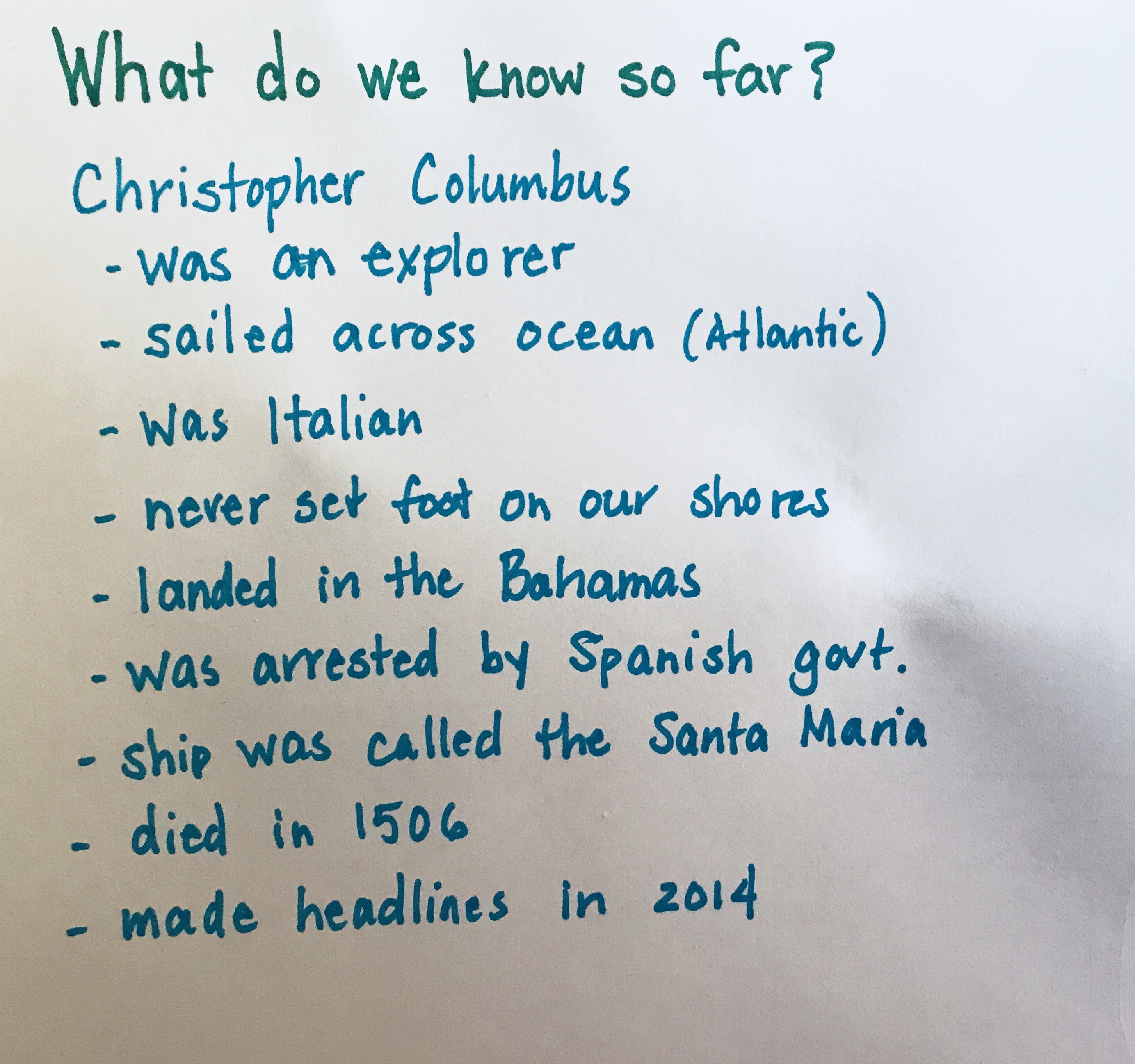


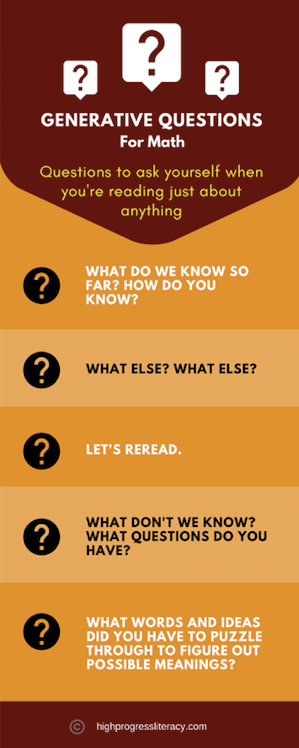
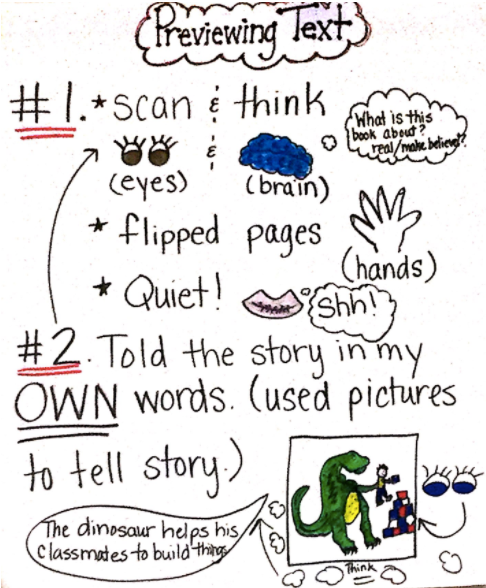
So helpful! Looking forward to being more explicit with my high schoolers about the REAL reason readers preview! Can’t wait to dig in using the generative questions!!
Melonee, I’m so glad! As long as we have been doing this and trying this, we are still learning, yes? I think one of the most important things the Generative Questions do for us as teachers, is to remind us–force us–to trust the kids. They can do this if we expect and support their efforts!